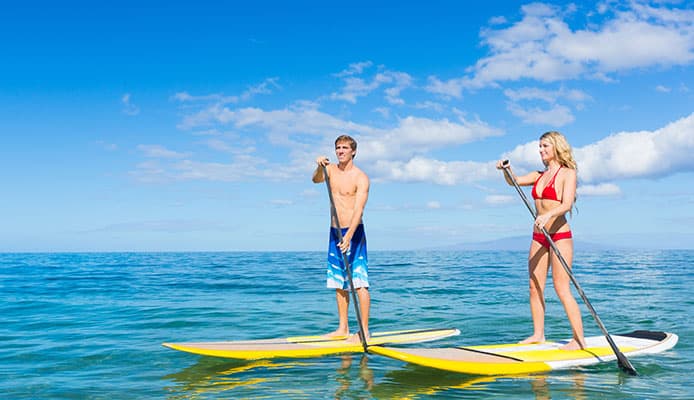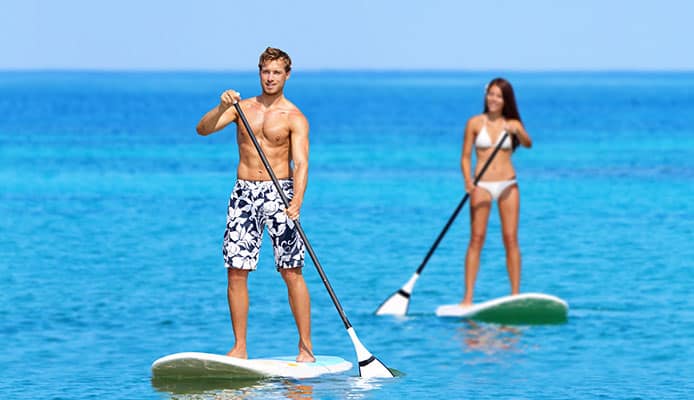
Gearing up for standup paddleboarding? Make sure to bring everything you need to stay safe and have a delightful moment on the water.
Good thing is that SUPing doesn’t really require that much gear. A good standup paddleboard, paddle, and right attitude will get you moving smoothly on the water.
But like any other watersport, you will need a few more essentials to make your experience even more comfortable. A useful rule of the thumb here is that don’t bring too much or too little gear – just what is right to make the moments memorable.
General Standup Paddleboarding Gear
So here is a quick standup paddleboarding gear checklist that will add to your enjoyment and keep you out of harm in the marine environment.
1. Paddle Board
There are different types of boards for different types of paddle sports. If you know exactly what you are looking for, you can just buy your board online or from a local retailer.
Depending on your needs, you can go for either a rigid or an inflatable paddleboard. Rigid boards come with a fixed shape and can’t be broken down or folded. They are easier to maneuver and control in choppy waters.
Inflatable boards, on the other hand, are cheaper and will best perform in calm waters. Experienced paddlers, however, can still ride them in rough waters.
On a side note, if you know how to kayak and would like to have a taste of both worlds, you may consider a SUP kayak hybrid. This will get you reaping the benefits of paddleboarding and kayaking from single equipment.
Make sure to familiarize yourself with all the parts of your standup paddleboard before heading out. Also, practice how to paddle your standup paddleboard beforehand so you can hone your skills and feel comfortable on the water.
2. Paddle
A SUP paddle is long and usually comes with an angled blade to give you more leverage on the water.
But cant my kayak paddle serve the same purpose? – You may ask!
Sure, if you own one, you may not feel convinced enough to spend on a SUP paddle. But kayak paddles are shorter and for an activity like this, you will need a longer paddle because you will be standing the entire time. The height between your arms and the water necessitates you to have a paddle of the right length.
3. Life Jacket
Another important item you don’t want to leave behind when packing your paddleboard equipment is a life jacket or a personal floatation device. Coast guard considers paddleboards as watercraft and requires paddlers to have their vests or PFDs on while on the water. Get acquainted with the coast guard requirements for inflatable PFDs so you don’t find yourself on the wrong side of the law.
Wear your vest before you paddle your board into the water especially if you can’t swim. Accidents are inevitable and won’t give you a warning before they happen. Your life jacket or PFD will be of no use to you if left lying in the car or at the shore.
4. Pump
If you are paddling an inflatable SUP, then you will need to bring your pump with you so you can keep the air inside your board regulated. When the weather is too hot, your vessel may need some deflating and when it’s too cold, it might need more inflating. Having your pump handy will keep the air pressure in your SUP balanced so it can have the right buoyancy and keep functioning properly.
5. Rescue Equipment
No one wants to find themselves in an emergency especially in the waters but sadly, on adventures like these, nothing is guaranteed. Therefore, it would be wise to have at least a rescue whistle and flashlight just in case things get awry.
A whistle will help you alert other watersports or faraway observers to your predicament, especially when paddling in isolated or rugged coastal areas. We don’t recommend SUPing in total darkness but if you really want to hit the waters at night, have a safety light too. If possible, bring a waterproof flashlight so that even if it comes into contact with water, it won’t get spoilt.
6. Leash
If you are a whitewater junkie and want to take your SUP paddle for an intense ride, then you may want to include a leash in your paddleboarding gear. A paddleboard leash will keep you tied to your craft in case of a fall or encounter with a wipeout.
You might also like: How To Size Up Your SUP Paddle Correctly
7. Right Clothing
The proper attire will go a long way in making your paddling more comfortable. If you are paddling in warm water, you will need nothing more than a good and nicely fitting swimsuit.
In places where the water temperature is below 65˚F, we strongly encourage an insulated wetsuit. In waters of temperatures between 50˚F and 55˚F or below, however, consider bringing a dry suit, especially if you are just starting to learn how to stand up paddleboard and fear that you may fall frequently. A dry suit will prevent the cold water from penetrating your skin, as exposure to almost freezing water could put you at risk of hypothermia.
8. UV Protection
The last piece of item (s) that you don’t want to exclude from your paddleboard equipment is sun protective clothing. If your skin is prone to sunburns, apply a considerable amount of reef-safe sunscreen or tanning lotion on your entire body.
Consider wearing a sunhat and a pair of polarized sunglasses too for added protection. Don’t forget your water shoes –your legs are part of the deal and they too need some protection!
Globo Surf Overview
Standup paddleboarding is a fun activity. But as with all watersports, one must go prepared. The above checklist contains all the gear pieces that you need to have a mind-blowing SUPing experience. But your safety comes first, so make sure to practice how to get back up on your SUP if you fall off and other stunts that may keep you safe on the water.
Single Products paddle Board Reviews:
Nixy Carbon Fiber Paddle Review


